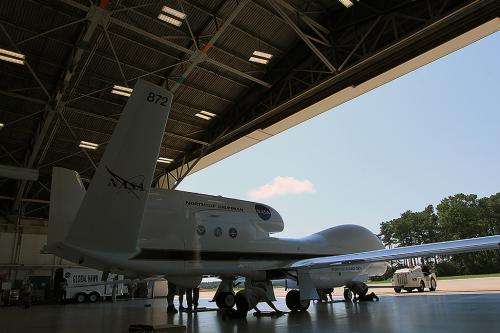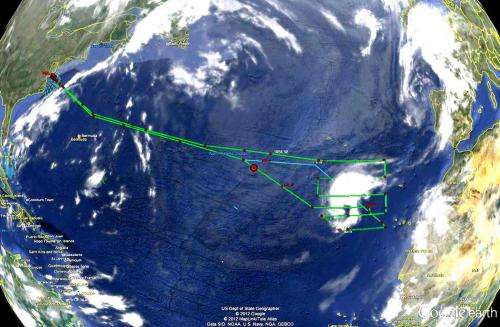NASA's HS3 mission aircraft to double team 2013 hurricane season

During this year's hurricane season NASA will "double-team" on research with two unmanned Global Hawk aircraft winging their way over storms that develop during the peak of the season. NASA's Hurricane and Severe Storm Sentinel, or HS3 airborne mission, will revisit the Atlantic Ocean to investigate storms using additional instruments and for the first time two Global Hawks.
"The advantage this year over 2012 is that the second aircraft will measure eyewall and rainband winds and precipitation, something we didn't get to do last year," said Scott Braun, HS3 mission principal investigator and research meteorologist at NASA's Goddard Space Flight Center in Greenbelt, Md. "In addition, just as we did in 2012, the first aircraft will examine the large-scale environment that tropical storms form in and move through and how that environment affects the inner workings of the storms."
HS3 is a mission that brings together several NASA centers with federal and university partners to investigate the processes that underlie hurricane formation and intensity change in the Atlantic Ocean basin. Among those factors, HS3 will address the controversial role of the hot, dry and dusty Saharan Air Layer in tropical storm formation and intensification, and the extent to which deep convection in the inner-core region of storms is a key driver of intensity change.
The HS3 mission will operate between Aug. 20 and Sept. 23. The Atlantic hurricane season runs from June 1 to November 30 and usually peaks in early to mid-September.
The NASA Global Hawks are unmanned aircraft that will be piloted remotely from the HS3 mission base at NASA's Wallops Flight Facility in Wallops Island, Va. Global Hawk aircraft are well-suited for hurricane investigations because they can fly for as long as 28 hours and over-fly hurricanes at altitudes greater than 60,000 feet.
The second Global Hawk will carry a payload of a Doppler radar for wind and precipitation measurements, a microwave radiometer for surface wind measurements, and a microwave sounder for the measurement of atmospheric temperature and humidity profiles. In addition, an instrument called ADELE (Airborne Detector for Energetic Lightning Emissions) is being added to examine gamma ray emissions caused by lightning. The ADELE instrument first flew on a Gulfstream V aircraft in 2009.

The radar and microwave instruments will fly aboard Global Hawk Two for the first time in HS3 and will focus on the inner region of the storms. The High-Altitude Imaging Wind and Rain Airborne Profiler conically scanning Doppler radar, the Hurricane Imaging Radiometer, and the High-Altitude Monolithic Microwave Integrated Circuit Sounding Radiometer microwave sounder will be new to the mission this year. These instruments have previously participated in NASA's GRIP (Genesis and Rapid Intensification Processes) experiment that studied hurricanes during the 2010 season and represent advanced technologies developed by NASA that are precursors to potential future satellite sensors
This year, one HS3 mission Global Hawk will provide the opportunity to test out a non-hurricane related instrument: the ADELE gamma ray detector.
Making a return appearance to NASA Wallops for the 2013 season and flying on Global Hawk One are three instruments to examine the environment of the storms. The scanning High-resolution Interferometer Sounder, the Advanced Vertical Atmospheric Profiling System also known as dropsondes, and the Cloud Physics Lidar will be mounted in the Global Hawk that will be studying the environment around storms.
Wallops Flight Facility is one of several NASA centers involved with the HS3 mission. The Earth Science Projects Office at NASA Ames Research Center manages the project. Other participants include NASA Goddard, NASA Dryden Flight Research Center, Edwards, Calif., NASA Marshall Space Flight Center, Huntsville, Ala. and NASA's Jet Propulsion Laboratory, Pasadena, Calif.
The HS3 mission is funded by NASA Headquarters and managed by NASA's Earth System Science Pathfinder Program at NASA's Langley Research Center, Hampton, Va., and is one of five large field campaigns operating under the Earth Venture program. The HS3 mission also involves collaborations with various partners including the National Centers for Environmental Prediction, Naval Postgraduate School, Naval Research Laboratory, NOAA's Hurricane Research Division and Earth System Research Laboratory, Northrop Grumman Space Technology, National Center for Atmospheric Research, State University of New York at Albany, University of Maryland - Baltimore County, University of Wisconsin, and University of Utah.
More information: science.nasa.gov/missions/hs3/
Provided by NASA's Goddard Space Flight Center




















